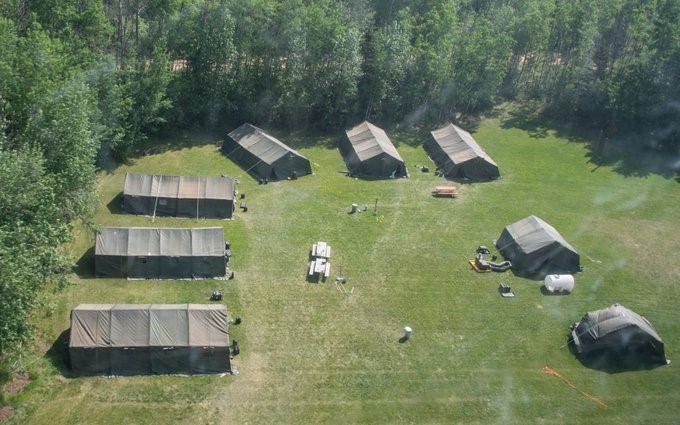November 7, 2023
The Innovation for Defence Excellence and Security (IDEaS) program recently awarded a $2-million grand prize in the Pop up city contest, to build more efficient “green” energy, water and waste management solutions for camps used by the Canadian Armed Forces.
In 2019, the IDEaS program launched the Pop up city contest, a four-round challenge to build integrated energy, water, and waste management systems for temporary and relocatable military camps. The goal was to showcase the “art of the possible” and build a system capable of minimizing the environmental footprint of these camps.
After four rounds, more than 100 applications, 42 promising technologies, a partnering event, and a pitch event, three finalists were selected: the Circular City team, led by Innocorps Research Corporation, the Autonomous Resilient Community Systems (ARCS) team, led by Terragon Environmental Technologies Inc., and the Integrated Utility Management System (IUMS) team, led by SNC-Lavalin.
 In August 2023, the three teams transported their fully built prototypes to an airstrip at Canadian Forces Base Suffield in Alberta to showcase them to the Canadian Armed Forces, representatives of other Canadians government departments, and not-for-profit organizations.
In August 2023, the three teams transported their fully built prototypes to an airstrip at Canadian Forces Base Suffield in Alberta to showcase them to the Canadian Armed Forces, representatives of other Canadians government departments, and not-for-profit organizations.
Over the course of a week, the three teams competed head-to-head for a chance to be declared “Top Dog” in the contest.
One of the requirements of the contest was that innovators had to work together to build an integrated solution. Another was that the technology would be portable and had to fit in a standard shipping container. Innovators had to demonstrate at least a 33% increased efficiency in water, wastewater and energy systems. Each company showcased solutions that incorporated novel battery, waste management and water treatment technology.
“The collaborative efforts have been truly inspiring,” says LCol Marc Comeau, joint engineer for the contest sponsor, the Canadian Joint Operations Command (CJOC).
One of the Circular City team’s solution focus was on making more clean water, while drawing less water from local sources, by treating and reusing as much greywater as possible. One of the innovations developed during this contest was adapting their treatment system for portability. Their advanced water treatment system uses “high recovery reverse osmosis” combined with other processes to produce more potable water while drawing less water from the environment.
IDEaS program contest evaluators were impressed with the system’s ability to provide a constant flow of warm water on demand, while maintaining enough water quantity in reserve for purposes such as extinguishing fires.
The Circular City power solution used portable batteries in shipping containers with a smart grid which triggered a generator only when needed, ensuring stable and sufficient power on demand for the needs of the camp.
 The Autonomous Resilient Community Systems (ARCS) team’s system uses solar panels and small-scale wind turbines to generate power in a system that “rolls out” in rows from portable containers with minimal maintenance.
The Autonomous Resilient Community Systems (ARCS) team’s system uses solar panels and small-scale wind turbines to generate power in a system that “rolls out” in rows from portable containers with minimal maintenance.
Contest evaluators were impressed with the system’s waste incinerator, which can handle solid and liquid waste from kitchen and facilities, living quarters and work centres, including items that cannot traditionally be safely disposed of in an incinerator such as petroleum, oil and lubricants.
The Integrated Utility Management System (IUMS) team’s Grengine solution uses a wind turbine array, paired with optional solar panels in an ultra-lightweight and scalable portable solution with rapid set up. The system is connected to the water and waste systems of the camp through an advanced microgrid.
IDEaS evaluators were impressed with the Grengine energy solution, that uses “plug and play” racks to swap batteries and inverters, which convert from alternating current to direct current electricity. The flexibility and resilience of the system stood out because it does not require special training to swap the batteries and inverters.
Alongside Canadian Armed Forces representatives, visitors from other government departments and private sector organizations were invited to watch the contest in action. The technology is relevant in multiple civilian contexts, from disaster relief to providing clean drinking water for remote communities.
Organizations like the Canadian Red Cross, who are looking to “green” their field operations, were impressed with the possibilities.
“We are excited to review some of the entries to determine if there is a potential solution to the challenges we face, and if there could be a role in future operations,” said Garth Tohms, senior manager for supply chain systems and business optimization for the Canadian Red Cross.
While all finalists brought unique approaches, the entry led by Innocorps Research Corporation took the grand prize. Dubbed “Circular City,” the team was able to best meet the criteria established under round 4 of the contest and won the $2 million grand prize.
Through this collaborative approach, IDEaS, the Department of National Defence, and the Canadian Armed Forces are supporting the development of new technologies, novel approaches, and transformative ideas into real-world applicability,fostering innovation in the defence and security sectors in Canada.
Related links:
- Pop up city: Integrating energy, water and waste management systems for deployed camps
- Defence Research and Development Canada
